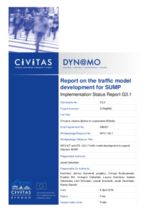Traffic model development to expand Gdynia's SUMP
Thematic areas
Integrated & inclusive planning
Summary
Gdynia has elaborated the first three-level transport model for both, individual and public transport for the city. It has been based on a full scope traffic research for the City of Gdynia and it was used to complete the City’s SUMP. The result was a macroscopic, a mesoscopic and a microscopic model, each addressing different transport and mobility aspects in the city and the region.
Implementing sustainable mobility
The modal shift in Gdynia has been undergoing a considerable change from public transport (PT) to private cars since the early 1990’s. Today, the share of public transport in Gdynia is 52%. Individual transport is at 47% and cycling only at 1%. The PT system consists of three subsystems: buses, trolleybuses and urban railway.
Since 1996, Gdynia’s Public Transport Authority (ZKM) has conducted every 2 years a research on citizens’ transport preferences and behaviour in the City of Gdynia and its vicinity. The research has been used to provide the best possible demand driven PT service for the local community. However, the survey focused mainly on PT and did not give a full picture of the transport system in Gdynia. There was no complex transport model existing for the city and therefore there was still the need to conduct an additional traffic survey with a wider scope.
For the first time, Gdynia elaborated a three-level transport model for both individual and public transport for the city. It has been based on a full scope traffic research for the City of Gdynia and was used to complete the city’s new SUMP. It served as an excellent visualisation tool to present urban mobility strategies and implementation options to stakeholders and the public.
The main objectives of this measure were:
- Set-up sound data and information for updating Gdynia's SUMP Set-up of a three-level transport model for Gdynia
- Accomplishment of detailed analyses and verification of effects on mobility management initiated by SUMP proposals and measures
- Realisation of infrastructure improvements aimed at increasing the attractiveness of alternative modes of transport
Progress
Planning & preparation
During the preparation phase, a complex traffic survey for Gdynia was conducted. To elaborate a transport model, the survey covered both individual and public transport to investigate the transport behaviour, preferences and needs of the local community. The survey has been used as starting point to expand the current SUMP.
Implementation & demonstration
During the implementation phase the transport model for Gdynia wwere elaborated by the Gdansk University of Technology. The transport model consisted of three levels:
- Macroscopic model (based on the VISUM programme): The Gdansk University of Technology operated the transport model for individual transport for the Pomorskie Voivodeship. The model required disaggregation of districts within the area of the City of Gdynia together with detailed road networks and elaboration of transport lines and running of PT within the city. The model has been used to implement the DYN@MO measures Advancing towards a dynamic SUMP and Community project studies from SUMP. It has also been used to collect the data for the mesoscopic model, complying with the planned routes located in the vicinity of the city.
- Mesoscopic model (based on the SATURN programme): This model was used to analyse the scenarios of traffic organisation modifications and other activities within the CIVITAS-DYN@MO measures. The model derived the results from the macroscopic model within the scope of demand modelling with a parallel division into particular modes of transport. This enabled calibration with taking into account the road network within the Pomorskie Voivodeship (results from the macroscopic model). The macroscopic and the mesoscopic models provided the basis for the elaboration of the microscopic model (3D simulations).
- Microscopic model (based on the VISSIM programme): This model allowed verification and demonstration of results obtained from the macro- and mesoscopic models and provided important input for the CIVITAS-DYN@MO measures Advancing towards a dynamic SUMP, and the planned internet platform. After implementation of ITS in Gdynia, the models have been supplied with the information on traffic intensity in real-time. Microscopic model (simulation and visualisation) has been elaborated for the chosen fragments of Gdynia's transport structure – for implementing the Community project studies from SUMP.
Outcomes
Tangible outputs:
- First transport model for Gdynia to be used in traffic management and transport planning
- Inputs to enhance and update Gdynia’s current SUMP
Expected outcomes in the short- to medium-term:
- Possibility of choosing the optimum solutions within mobility management with the use of analyses from measure Community project studies from SUMP
Expected outcomes in the mid- to long-term:
- Possibility of long-term planning within the mobility management which will contribute to the increase of attractiveness of PT and alternative modes of transport and consequently contribute to a reduction of air pollution and amelioration of quality of life of the city’s inhabitants.









